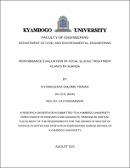| dc.description.abstract | With the inevitably increasing urbanization of various cities, there has come an increasing amount
of fecal sludge collected in all cities globally. Such an incidence has consequentially led to the
increasing need to not only manage but also treat all fecal sludge following cognizance of the
effects of poorly treated fecal sludge on public and environmental health. Fecal sludge treatment
plants have been and still are being constructed, with engineers coming up with innovative designs
for purposes of treating sludge, even in Uganda. However, whereas the plant construction process
is much prioritized, there have been gaps in performance of the plants registered, globally. Those
gaps are indicated by the persistence of coliforms, and solids in plant effluent, as reported in
various countries. The purpose of this study was to evaluate the performance of fecal sludge
treatment plants in Uganda with focus on effluent discharge, and what determines it. The
assessment of plant design characteristics revealed that all of them had septage/ sludge reception
points, coarse screening screens for grit and solid separation from sludge, all of which were
manually raked. The majority of the plants had no sedimentation tanks. However, for those which
had sedimentation tanks, they were of the settling-thickening type. The majority of the plants did
not have anaerobic ponds, but for those that had anaerobic ponds, all had anaerobic baffled
reactors. All plants had aerobic ponds that were all facultative. All plants had dewatering beds. All
the plants had pathogen removal ponds, with the majority being constructed wetlands. Four fifths
of the plants sampled did not have parts/processes for further drying/pathogen reduction. The level
of performance of the fecal sludge treatment plants in Uganda is 40%. Optimal fecal sludge
treatment performance was twice as likely at plants where the administrative staffs were permanent
employees (aPR = 2.757 [1.515 - 6.114], p =0.028). In conclusion, Fecal Sludge Treatment Plants
in the Uganda are generally designed with septage/ sludge reception points; they have coarse
screening screens for grit and solid separation from sludge, all of which were manually raked.
However, the majority of the plants have no sedimentation tanks, yet and neither do they have
anaerobic ponds, yet they all have aerobic ponds of all which were facultative in design. All plants
have pathogen removal ponds, but without processes for further drying/pathogen reduction. Fecal
Sludge Treatment Plants in Uganda sub optimally perform, only 4 in 10 of them discharge effluent
with more than 80% of its bio and physicoc-hemical characteristics compliant with national
standards in terms of quantity. Staff characteristics are the only ones that are associated with FSTP
performance. | en_US |

